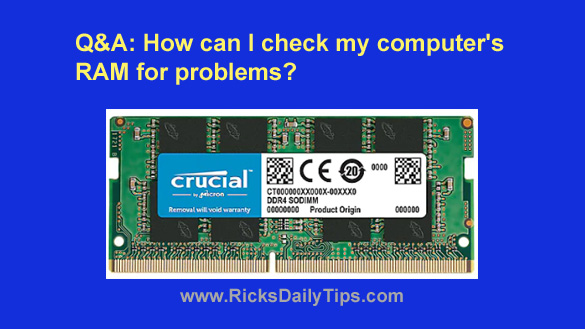 Question from Mac G.: I have a four year old Acer laptop that recently started crashing to blue screens at random times.
Question from Mac G.: I have a four year old Acer laptop that recently started crashing to blue screens at random times.
A first it would only happen about once or twice a month but now they’re popping up at least once a day.
I thought it might be a software issue so I followed your instructions for resetting Windows 10 but that didn’t help. The blue screens continued popping up even with no programs installed.
My next thought is maybe my computer has a RAM chip that went bad.
First of all, what are your thoughts about the possibility of bad RAM being the problem?
And second, if you do suspect a RAM problem how’s the best way to check the RAM to see if it’s in fact bad?
Rick’s answer: I have a feeling you’re right on the money with your analysis, Mac.
Any time a Windows computer starts displaying BSODs (aka “blue screens of death”) I always try to rule out a software issue first.
You have already done that (more or less) by performing the Windows 10 reset, but the numeric error codes displayed on the screen will often point you in the right direction in regards to troubleshooting.
The folks over at Lifewire have published a comprehensive list of BSOD error codes. You can always compare the error code(s) you’re getting to the ones on that list to help track down the culprit.
But that being said, in your case I strongly suspect that a defective RAM module is indeed the culprit. The best way to find out for sure is to run a couple of memory diagnostic tests.
Window 10 itself has a native RAM diagnostic tool that you can use for the initial test, and it couldn’t be easier to use. Simply follow the steps below:
1 – Click the Start button.
2 – Type the words windows memory diagnostic. A list of search results should appear.
3 – Select Windows Memory Diagnostic from the list of search results.
4 – Click Restart now and check for problems.
Your PC should now shut down and then immediately boot up into the Memory Diagnostic Tool with the test already running.
After the test is complete the machine should restart and boot up into Windows with the results of the test displayed on the screen.
If any errors were found you’ll know bad RAM is indeed the culprit.
If you decide to fix the problem by replacing the bad RAM I recommend that you replace all the installed RAM sticks at the same time.
I say this because even though it’s likely that only one RAM stick is bad at this point in time, the other sticks are the same age and quality as the bad one. That means they could fail as well at any time.
Also, by replacing all the RAM sticks at once you can avoid any potential issues caused by mis-matched RAM.
Note: This is also an excellent time to consider upgrading your system with more RAM.
Now, if the Windows Memory Diagnostic tool didn’t find any errors I recommend that you get a second opinion by running a free third-party RAM diagnostic tool called MemTest86. (You’ll find instructions for using it here.)
If you do end up needing to replace your RAM sticks I recommend that you use the awesome (and free) System Scanner tool at Crucial.com to determine exactly what type of RAM stick you’ll need (and how many).
Bottom line: While I believe you’ll find that a bad RAM stick is causing your BDODs to appear it never hurts to be sure before laying out the cash to buy replacement RAM.
The tools mentioned above will help you find out for sure.
Never miss a tip! Click here to sign up for my free Daily Tech Tips Email Newsletter!